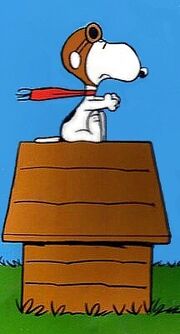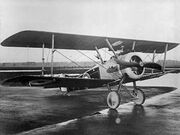No edit summary Tag: rte-source |
(Avoiding redirect.) Tag: sourceedit |
||
| Line 2: | Line 2: | ||
==In the comic strip== |
==In the comic strip== |
||
| − | Snoopy, as his most famous and popular [[List of Snoopy's alter egos|alter ego]], the [[World War I Flying Ace]], sits on top of his doghouse, and pretends it is a Sopwith Camel, and imagines his battles with the Red Baron. Sometimes, Snoopy has used the plane to fly places, and not for war, for instance, in a series of strips from [[July 1980 comic strips|July]] and [[August 1980 comic strips|August 1980]], he tries to fly [[Schroeder]] to music camp. In a series of strips from [[June 1975 comic strips|June]] and [[July 1975 comic strips|July 1975]], Snoopy rents out his Sopwith Camel to [[ |
+ | Snoopy, as his most famous and popular [[List of Snoopy's alter egos|alter ego]], the [[World War I Flying Ace]], sits on top of his doghouse, and pretends it is a Sopwith Camel, and imagines his battles with the Red Baron. Sometimes, Snoopy has used the plane to fly places, and not for war, for instance, in a series of strips from [[July 1980 comic strips|July]] and [[August 1980 comic strips|August 1980]], he tries to fly [[Schroeder]] to music camp. In a series of strips from [[June 1975 comic strips|June]] and [[July 1975 comic strips|July 1975]], Snoopy rents out his Sopwith Camel to [[Peppermint Patty]] and [[Marcie]], so that they can compete in the [[wikipedia:Powder Puff Derby|Powder Puff Derby]]. |
When Snoopy is flying and fighting, it can often be seen that there are bullets in his plane. This could imply that the Red Baron is not imaginary, since he really shoots the plane. However, it is most likely that the bullets are part of Snoopy's imagination as well. |
When Snoopy is flying and fighting, it can often be seen that there are bullets in his plane. This could imply that the Red Baron is not imaginary, since he really shoots the plane. However, it is most likely that the bullets are part of Snoopy's imagination as well. |
||
Revision as of 11:18, 25 August 2015

Snoopy flying his Sopwith Camel
The Sopwith Camel was a British World War I single-seat biplane fighter introduced on the Western Front in 1917. In the Peanuts comic strip, Snoopy pretends his doghouse is a Sopwith Camel, and pretends to fight the Red Baron with it.
In the comic strip
Snoopy, as his most famous and popular alter ego, the World War I Flying Ace, sits on top of his doghouse, and pretends it is a Sopwith Camel, and imagines his battles with the Red Baron. Sometimes, Snoopy has used the plane to fly places, and not for war, for instance, in a series of strips from July and August 1980, he tries to fly Schroeder to music camp. In a series of strips from June and July 1975, Snoopy rents out his Sopwith Camel to Peppermint Patty and Marcie, so that they can compete in the Powder Puff Derby.
When Snoopy is flying and fighting, it can often be seen that there are bullets in his plane. This could imply that the Red Baron is not imaginary, since he really shoots the plane. However, it is most likely that the bullets are part of Snoopy's imagination as well.
In the real world
The type entered squadron service in June 1917 with No. 4 Squadron of the Royal Naval Air Service, near Dunkirk. The following month, it became operational with No. 70 Squadron of the Royal Flying Corps. By February 1918, 13 squadrons were fully equipped with the Camel.
The Camel proved to be a superlative fighter, and offered heavier armament and better performance than the Pup and Triplane. In the hands of an experienced pilot, its maneuverability was unmatched by any contemporary

A real life version of a Sopwith Camel
type. Its controls were light and sensitive. The Camel turned rather slowly to the left, which resulted in a nose up attitude due to the torque of the rotary engine. But the engine torque also resulted in the ability to turn to the right in half the time of other fighters, although that resulted in more of a tendency towards a nose down attitude from the turn. Because of the faster turning capability to the right, to change heading 90° to the left, many pilots preferred to do it by turning 270° to the right.
Agility in combat made the Camel one of the best-remembered Allied aircraft of the First World War. It was said in jest to offer a choice between a "wooden cross, red cross and Victoria Cross." Together with the S.E.5a, the Camel helped to wrest aerial superiority away from the German Albatros fighters.
Major William Barker's Sopwith Camel (serial no. B6313, the aircraft in which the majority of his victories were scored) became the most successful fighter aircraft in the history of the RAF, shooting down 46 aircraft and balloons from September 1917 to September 1918 in 404 operational hours flying. It was dismantled in October 1918. Barker kept the clock as a memento, but was asked to return it the following day.
By mid-1918 the Camel was becoming limited by its slow speed and comparatively poor performance at altitudes over 12,000 ft (3,650 m). However, it was then used as a ground-attack and infantry support aircraft. During the German offensive of March 1918, flights of Camels harassed the advancing German Army, inflicting high losses (and suffering high losses in turn) through the dropping of 25 lb (11 kg) Cooper bombs and ultra-low-level strafing. The protracted development of the Camel's replacement, the Sopwith Snipe, meant that the Camel remained in service until the Armistice.
In summer 1918 a 2F.1 Camel (N6814) was used in trials as a parasite fighter under Airship R23
